 |
 |
 |
 |
 |
 |
| |
 |
|
 |
 |
 |
  |
  |
 |
 |
 |
 |
|
|
 |
|
 |
 |
 |
BUILDING |
 |
|
 |
|
 |
 |
 |
| |
 |
| 
 |
Ardmore Residence
|
|
 |
 |
 |
 |
DESIGNER |
 |
|
|
 |
|
 |
 |
 |
| |
 |
|
 |
 |
 |
 |
DESCRIPTION |
 |
|
|
 |
|
 |
 |
 |
|
|
 |
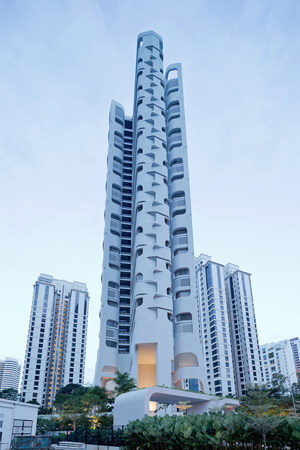 In recent years high-rise residential towers is Asia have undergone a significant transformation. No longer only mass replicated tower blocks dot the skyline of most Asian cities, a new generation of bespoke towers now provide aesthetic, singular silhouettes and incorporate comfortable living spaces, attractive landscaped gardens and an array of amenities for residents. In recent years high-rise residential towers is Asia have undergone a significant transformation. No longer only mass replicated tower blocks dot the skyline of most Asian cities, a new generation of bespoke towers now provide aesthetic, singular silhouettes and incorporate comfortable living spaces, attractive landscaped gardens and an array of amenities for residents.
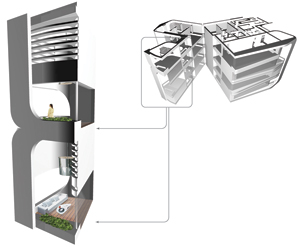 The Ardmore Residence at 7 Ardmore Park in Singapore is one of this new breed of residential towers. Located in a prime location close to the Orchard Road luxury shopping district the Ardmore Residence enjoys both expansive views of the panoramic cityscape of Singapore City and the vast green areas of its immediate western and eastern surroundings. The Ardmore Residence at 7 Ardmore Park in Singapore is one of this new breed of residential towers. Located in a prime location close to the Orchard Road luxury shopping district the Ardmore Residence enjoys both expansive views of the panoramic cityscape of Singapore City and the vast green areas of its immediate western and eastern surroundings. |
|
 |
 |
 |
|
 |
|
| Living landscape |
 |
|
 |
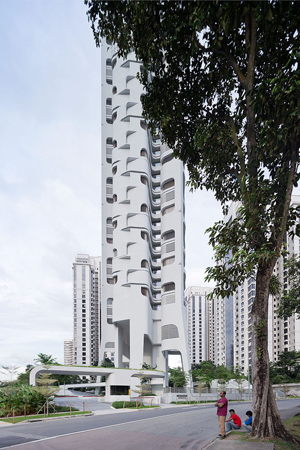 The primary concept for the design of the 36 storey, 17.178 m² residential tower is a multi-layered architectural response to the natural landscape inherent to the ‘Garden City’ of Singapore. This landscape concept is integrated into the design by means of four large details: the articulation of the facade, which through its detailing creates various organic textures and patterns; expansive views across the city made possible by large glazed areas, bay windows and double-height balconies; the interior ‘living landscape’ concept adopted for the design of the two apartment types and the introduction of transparency and connectivity to the ground level gardens by means of a raised structure supported by an open framework. The primary concept for the design of the 36 storey, 17.178 m² residential tower is a multi-layered architectural response to the natural landscape inherent to the ‘Garden City’ of Singapore. This landscape concept is integrated into the design by means of four large details: the articulation of the facade, which through its detailing creates various organic textures and patterns; expansive views across the city made possible by large glazed areas, bay windows and double-height balconies; the interior ‘living landscape’ concept adopted for the design of the two apartment types and the introduction of transparency and connectivity to the ground level gardens by means of a raised structure supported by an open framework. |
|
 |
 |
 |
|
 |
|
| Textured facade |
 |
|
 |
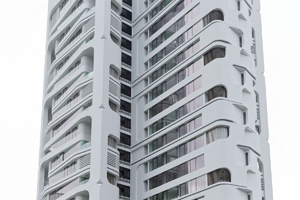 The facade of the Ardmore Residence is derived from micro-design features which interweave structural elements, such as bay windows and balconies into one continuous line. The façade pattern is repeated for every four storeys of the building, whilst rounded glass creates column-free corners, visually merging the internal spaces with the external balconies. Intertwining lines and surfaces wrap the apartments, seamlessly incorporating sun screening, whilst also ensuring that the inner qualities of the apartments and the outer appearance of the building together form a unified whole. From a distance the tower appears to adopt vastly divergent contours when viewed from different perspectives, whilst from close by the various openings in the concrete panels of the facade affect a sense of organic mutation and transition as you move around the building. The facade of the Ardmore Residence is derived from micro-design features which interweave structural elements, such as bay windows and balconies into one continuous line. The façade pattern is repeated for every four storeys of the building, whilst rounded glass creates column-free corners, visually merging the internal spaces with the external balconies. Intertwining lines and surfaces wrap the apartments, seamlessly incorporating sun screening, whilst also ensuring that the inner qualities of the apartments and the outer appearance of the building together form a unified whole. From a distance the tower appears to adopt vastly divergent contours when viewed from different perspectives, whilst from close by the various openings in the concrete panels of the facade affect a sense of organic mutation and transition as you move around the building. |
|
 |
 |
 |
|
 |
|
| Inside-outside landscape |
 |
|
 |
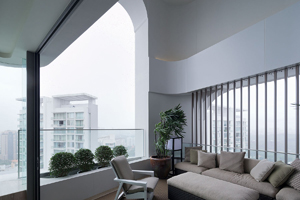 The apartments in the Ardmore Residence embody the idea of a ‘living landscape’. Functional spaces are redefined and extended into the living landscape concept, offering the possibility for versatile functionality for the occupants. An indoor-outdoor living experience is achieved through the inclusion of large windows and double height balconies in all of the residences. These elements enable a wide variety of views across Singapore City, while the large vertical balconies additionally offset the horizontality of the more private interior spaces. With the terrace spaces integrated into every-day internal living scenarios, the living landscape promotes seamlessness between interior and exterior spaces. Bay window features on the façade create natural shading on the glass to minimize heat gain and provide welcome opportunity for planting by the residents. The apartments in the Ardmore Residence embody the idea of a ‘living landscape’. Functional spaces are redefined and extended into the living landscape concept, offering the possibility for versatile functionality for the occupants. An indoor-outdoor living experience is achieved through the inclusion of large windows and double height balconies in all of the residences. These elements enable a wide variety of views across Singapore City, while the large vertical balconies additionally offset the horizontality of the more private interior spaces. With the terrace spaces integrated into every-day internal living scenarios, the living landscape promotes seamlessness between interior and exterior spaces. Bay window features on the façade create natural shading on the glass to minimize heat gain and provide welcome opportunity for planting by the residents.
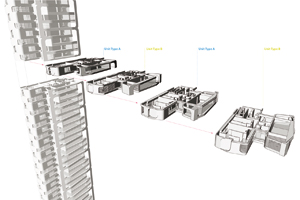 The floor plan chosen for the 58 individual apartments is designed to increase the amount of daylight and take full advantage of the panoramic views, thereby creating an atmosphere of spaciousness in the dwellings. This floor plan is based on an analysis of Renaissance villa prototypes – and the concept of a “cours d’honneur” as in between space which enable visual links between different parts of one and the same house. In the design for the Ardmore Residence this concept is appropriated and translated in order to allow for visual interconnection between specific areas within the apartments. This concept furthermore increases privacy for sleeping rooms and adds a four-dimensional aspect to the layout, as both wings can operate separately, service different needs and be active at different times of the day. The floor plan chosen for the 58 individual apartments is designed to increase the amount of daylight and take full advantage of the panoramic views, thereby creating an atmosphere of spaciousness in the dwellings. This floor plan is based on an analysis of Renaissance villa prototypes – and the concept of a “cours d’honneur” as in between space which enable visual links between different parts of one and the same house. In the design for the Ardmore Residence this concept is appropriated and translated in order to allow for visual interconnection between specific areas within the apartments. This concept furthermore increases privacy for sleeping rooms and adds a four-dimensional aspect to the layout, as both wings can operate separately, service different needs and be active at different times of the day. |
|
 |
 |
 |
|
 |
|
| Continuous landscape |
 |
|
 |
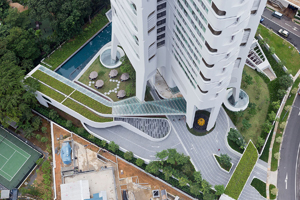 The first residential level of the Ardmore Residence is located on the eighth storey of the building. An open framework is therefore introduced at the base of the raised tower which enables full connectivity and transparency across the ground level landscaping, while simultaneously organising the shared amenity facilities. Whilst building regulations in Singapore specify both the height and area of high-rise buildings, views are also deemed to be essential for the occupants. The raised design of the Ardmore Residence therefore integrally incorporates these set parameters to take full advantage of the potential they afford to optimise the design concept and simultaneously create a fully integrated living and leisure landscape for its occupants. The first residential level of the Ardmore Residence is located on the eighth storey of the building. An open framework is therefore introduced at the base of the raised tower which enables full connectivity and transparency across the ground level landscaping, while simultaneously organising the shared amenity facilities. Whilst building regulations in Singapore specify both the height and area of high-rise buildings, views are also deemed to be essential for the occupants. The raised design of the Ardmore Residence therefore integrally incorporates these set parameters to take full advantage of the potential they afford to optimise the design concept and simultaneously create a fully integrated living and leisure landscape for its occupants. |
|
 |
 |
 |
|
 |
|
|
|
 |
|
 |
 |
 |
|
 |
|
| Ben van Berkel |
 |
|
 |
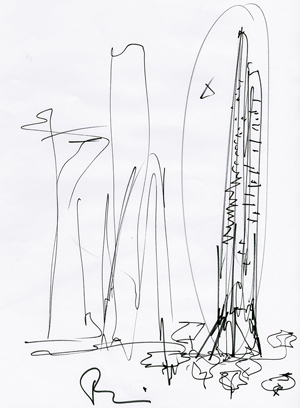 “The highly textural façade of the Ardmore Residence works in unison with the organisation of the individual apartments, affording both extensive daylight to the unique residential spaces and panoramic views over the city of Singapore. The façade further generates a unique reading of the building in the neighborhood, with its layered contours extending the appearance beyond four façades and providing a variety of profiles and perspectives.” “The highly textural façade of the Ardmore Residence works in unison with the organisation of the individual apartments, affording both extensive daylight to the unique residential spaces and panoramic views over the city of Singapore. The façade further generates a unique reading of the building in the neighborhood, with its layered contours extending the appearance beyond four façades and providing a variety of profiles and perspectives.” |
|
 |
 |
 |
 |
 |
 |
 |
LOCATION |
 |
|
|
 |
|
 |
 |
 |

|
 |

|
Continent |
|
 |
  Asia |
|
Nation |
|
 |
  Singapore |
|
Town |
|
 |
  Singapore |
|
Address |
|
 |
  7 Ardmore Park
|
|
|
|
 |
|
Telephone |
|
 |
|
Website |
|
 |
|
 |
 |
 |
 |
MAP |
 |
|
|
 |
|
 |
 |
 |
| |
 |
|
 |
 |
 |
 |
|
TYPOLOGY |
 |
|
|
 |
|
 |
 |
 |
|
|
 |
ARCHITECTURE | Residential buildings
Multiple dwelling
Vertical architectures
Skyscrapers
| |
 |
 |
 |
 |
CHRONOLOGY |
 |
|
|
 |
|
 |
 |
 |
Project |
 |
|
 |
| 
 |
2006
|
|
Realisation |
 |
|
 |
| 
 |
2013 |
|
 |
 |
 |
 |
CLIENT |
 |
|
|
 |
|
 |
 |
 |
| |
 |
|
 |
 |
 |
 |
DIMENSIONAL
DATA |
 |
|
|
 |
|
 |
 |
 |
| Floors |
 |
|
 |
|
| Surface |
 |
|
 |
apartments sq.m. 15,666
carpark sq.m. 4,400
site sq.m. 5,625 |
|
| Consistence |
 |
|
 |
|
 |
 |
 |
 |
STRUCTURES |
 |
|
|
 |
|
 |
 |
 |
| |
 |
|
 |
 |
 |
 |
STAFF |
 |
|
|
 |
|
 |
 |
 |
|
 |
|
Design team |
 |
| Ben van Berkel with Wouter de Jonge and Holger Hoffmann, Imola Berczi, Christian Bergmann, Aurelie Hsiao, Juergen Heinzel, Derrick Diporedjo, Nanang Santoso, Joerg Petri, Kristin Sandner, Katrin Zauner, Arne Nielsen, |
|
Architect of record |
 |
| Architects A61, Singapore |
|
Systems |
 |
| J Roger Preston, Singapore |
|
Facades consultant |
 |
|
Interior design |
 |
|
 |
 |
 |
 |
CREDITS |
 |
|
|
 |
|
 |
 |
 |
| |
 |
Photos © Iwan Baan
Drawings © UNStudio
Text edited by UNStudio
Courtesy by UNStudio
|
|
 |
  |
 |
|
|